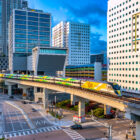By ERIC FREEDMAN
Capital News Service
LANSING – For novelist-to-be Maritta Wolff, the stone train station at Grass Lake near her grandparents’ farm in Jackson County represented escape from small town living. Twenty years ago, and shortly before her death, Wolff returned to her hometown by Amtrak for the dedication of the restored depot that inspired the title of her first best-seller, “Whistle Stop.”
For Pulitzer Prize-winning Civil War historian Bruce Catton, the train that served his Benzie County hometown of Benzonia sparked a restlessness. It also sparked nostalgia later in life that Catton captured in a best-selling memoir, “Waiting for the Morning Train.”
For Robert Frost, the future American poet laureate, arrival in Ann Arbor by train marked his becoming the University of Michigan’s first “fellow of the arts.”
These three writers were linked by Michigan ties, eventual renown as writers – and trains. “Ink Trails: Michigan’s Famous and Forgotten Authors” (Michigan State University Press, $19.95) by brothers Dave and Jack Dempsey, tells the stories of Wolff, Catton and Frost, as well as 16 other writers who were born or lived in the state. The others range from the well-remembered, such as Carl Sandburg, Ring Lardner and John Voelker, to the once-famous-now-forgotten, such as George Adams, Eugene Ruggles and Carroll Rankin.
